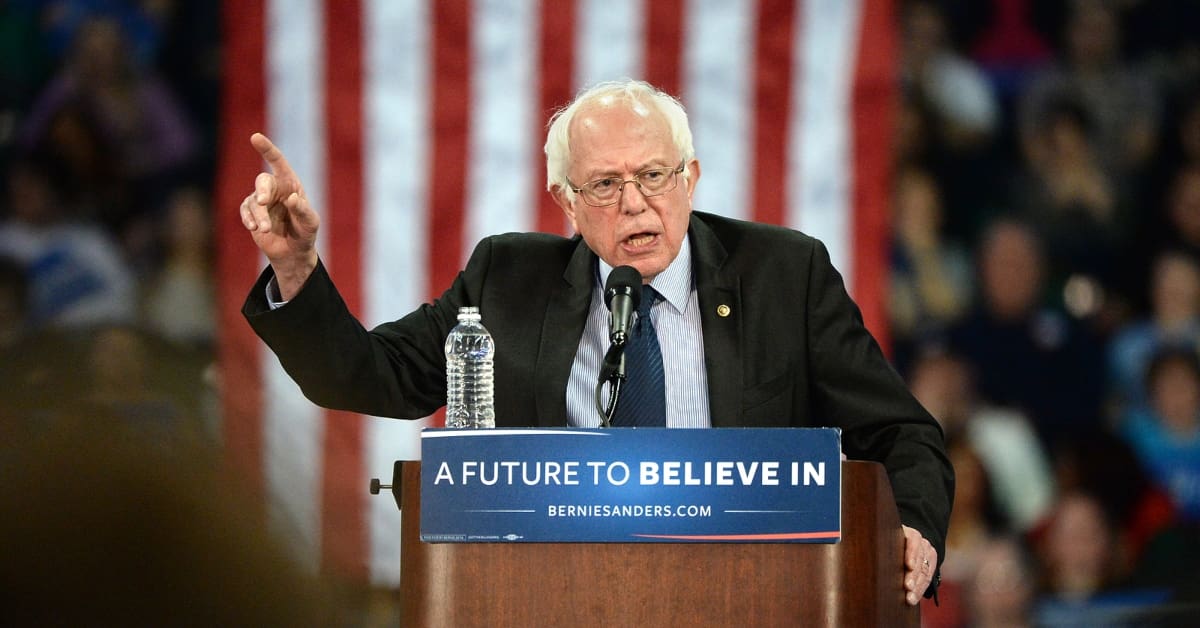
Sen. Bernie Sanders, D-Vt., says, “Good jobs require good education.” He wants to make public colleges and universities tuition-free and to cancel all student loan debt, according to his 2020 presidential campaign.
For a country whose students are drowning in debt, Sanders is stepping out to solve an issue many are concerned with.
Proposal promises free education for students and graduates
Sanders’ campaign website features his “College for All” proposal that outlines his stance on college tuition and student loan debt. Below are the promises he makes if he’s elected as the next president of the United States:
- Pass the College for All Act to provide at least $48 billion per year. This will drop all tuition and fees at four-year public colleges and universities, tribal colleges, community colleges, trade schools and apprenticeship programs.
- Cancel the entire $1.6 trillion in outstanding student debt for 45 million borrowers.
- Double funding for the Federal TRIO Programs and increases funding for GEAR UP (Gaining Early Awareness and Readiness for Undergraduate Programs). These enable low-income students, students with disabilities, and first-generation students to attend and graduate college.
- Provide Pell Grants to low-income students to cover the non-tuition and fee costs of school. This includes housing, books, supplies, transportation and other costs of living.
- Require participating states and tribes to cover the full cost of obtaining a degree for low-income students. “Low-income” is typically those with a household income of less than $25,000.
- Place a cap on student loan interest rates going forward. Under this proposal, student loan interest rates will be capped at 1.88%.
- In addition to eliminating tuition and fees, any additional spending from states and tribes will be matched, which reduces the cost of attending school at a dollar-for-dollar rate. Participating states and tribes could use this money to hire additional faculty, ensure professors get professional development opportunities and increase students’ access to educational opportunities.
- Triple funding for the Work-Study Program. The program will expand to reach at least 2.1 million students — a 1.4 million student increase. The funding will work to target schools that have large low-income student enrollment.
- Provide $1.3 billion to private, nonprofit Historically Black Colleges and Universities and Minority-Serving Institutions every year. This will eliminate or significantly reduce tuition and fees for low-income students. This funding would support some 200 schools that serve at least 35% low-income students.
Bernie Sanders knows how to set a lofty goal. Eliminating $1.6 trillion dollars in student loan debt is a massive undertaking — not to mention the many other programs he intends to move forward, if elected.
His plan to help make these promises happen relies on a tax for Wall Street. The tax is a fraction of a percent on Wall Street speculators. Sanders’ campaign states that this tax will raise $2.4 trillion over the next ten years. It works by placing a 0.5% tax on stock trades, or 50 cents on every $100 of stock; a 0.1% fee on bond trades; and a 0.005% fee on derivative trades.
Senator Warren's plan finances her loan forgiveness plan through a wealth tax. The Wall Street speculation tax would certainly impact financial and investment companies. It would also impact mutual funds, pensions, and ordinary investors when they buy or sell securities.
Pros and cons of Bernie Sanders’ beliefs on education
Sanders’ promise of canceling all student loan debt is an enticing piece of this proposal. Free tuition is a close second. The ripple effect of this freedom means more money in your pocket.
Sanders’ hope is that this will help close the racial wealth gap. Ideally, by ridding 44 million people of their student loan debt, the possibility to build wealth opens up.
Free tuition means you could go back to school and complete a higher degree. This offers you the opportunity to make more money. In the larger picture, wiping out student loan debt could stimulate the economy.
But whenever a politician promises to end all student loan debt, it can’t always close an equity gap. The majority of the benefit applies to those with the highest amount of student loan debt. Lawyers, dentists, and physicians who have student loan debt in the six figures would greatly benefit from no student debt, as it would leave them free to use their high salary.
In some cases, like with veterinarians, physical therapists, and social workers, it could be of great benefit with the “deadly middle”. These professions need a graduate degree and take on a large amount of student loan debt. But these careers don't offer a salary that matches the level of student debt that’s taken on.
Those who would benefit the least are individuals with smaller loan balances — typically, those who didn’t attend graduate school or didn’t finish a degree. This means their salaries are still low, limiting their financial opportunities.
Sanders’ removal of all student loan debt may exacerbate this equity gap. It allows those who do earn more to benefit on a larger scale than those who earn less.
How Bernie Sanders’ stance compares to the College for All Act
This isn’t the first time we’ve heard about free college tuition or reducing student loan debt. In 2017, Sanders worked on the College for All Act. This act had similarities to what he’s now proposing but contained a few more restrictions.
In the original College for All Act, Sanders’ stance on student loans was to help reduce them for most Americans. He proposed that the government would:
- Cut student loan interest rates in half
- Allow Americans to refinance their student loans at the lowest rate possible
- Prevent the federal government from profiting off of student loans
He didn't promise complete elimination of student loan debt in 2017. Instead, it was a way to give Americans some relief from student debt.
The 2017 College for All Act also proposed free college. Tuition and fees would be waived for those making up to $125,000. He also proposed that community college tuition be free for everyone. In his current stance, Bernie says he still wants to pass the College for All Act; however, according to his site, it would only be the part that makes college tuition-free.
In the initial 2017 proposal, Sanders looked to provide funding to close equity gaps in higher education. He asked legislation to double funding for programs like GEAR UP and TRIO, which allow more first-generation and low-income students to enroll in and graduate from college.
The focus to end the equity gap is still of great significance in his new campaign. Sanders is continuing to push for double the funding in these programs. He’s also looking to invest in minority-serving colleges and universities and to increase programs like work-study. It seems that his new 2020 campaign recognized some of the 2017 equity gaps in the policy. He has worked to correct them in some ways with specific goals.
How Bernie Sanders’ student loan stance compares to others
Bernie Sanders isn’t the only one running on a campaign that directly addresses student loans and college access.
Sen. Elizabeth Warren, D-Mass., also has a progressive student loan debt relief plan for 2020. Warren addresses the area that Sanders doesn’t — eliminating student loan debt based on income. Those who earn less will qualify for more forgiveness. Warren does align with Sanders in promoting a free-college-for-all plan.
It's true that forgiving all student loan debt would be regressive as it would disproportionately benefit high income earners. That is one reason Senator Warren's plan aims to forgive only $50,000 and means tests the benefit so that it phases out for six figure income households. Senator Sanders is the only major candidate that wants to forgive all student loans.
Sanders’ 2017 College for All Act was supported by another 2020 presidential candidate: Sen. Kamala Harris, D-Calif.. In her current campaign, she has taken a different approach by suggesting income-driven repayment be the default plan for all student loans. She also proposes capping federal interest rates at 3.5%. All students would have the opportunity to refinance for a lower rate under her plan.
On the opposite end of the Sanders campaign is the one proposed by President Trump. He proposes a single income-driven repayment plan that caps borrowers’ payments at 12.5%.
His plan is split into two for grad and undergrad students. Undergrad students would pay for 180 months. Any remaining balance after this time would be forgiven. Graduate students would have any remaining balance forgiven after 30 years of payments. To fund this new student loan repayment plan, Trump would cut the Public Service Loan Forgiveness (PSLF) program.
Sanders’ proposal stands at the top of the list for most forgiving when it comes to student debt.
Student loans and college tuition: A major 2020 election topic
The need to address the ever-mounting burden of student loans isn’t going unnoticed by other candidates. Over 22 candidates have addressed student loans and college costs in their campaigns.
Refinance student loans, get a bonus in 2024
| Lender Name | Lender | Offer | Learn more |
|---|---|---|---|

|
$500 Bonus
*Includes optional 0.25% Auto Pay discount. For 100k or more.
|
Fixed 5.24 - 9.99% APR*
Variable 6.24 - 9.99% APR*
|
|

|
$1,000 Bonus
For 100k or more. $300 for 50k to $99,999
|
Fixed 5.19 - 10.24% APPR
Variable 5.28 - 10.24% APR
|
|

|
$1,000 Bonus
For 100k or more. $200 for 50k to $99,999
|
Fixed 5.19 - 9.74% APR
Variable 5.99 - 9.74% APR
|
|

|
$1,050 Bonus
For 100k+, $300 for 50k to 99k.
|
Fixed 5.44 - 9.75% APR
Variable 5.49 - 9.95% APR
|
|

|
$1,275 Bonus
For 150k+, $300 to $575 for 50k to 149k.
|
Fixed 5.48 - 8.69% APR
Variable 5.28 - 8.99% APR
|
|

|
$1,250 Bonus
For 100k+, $350 for 50k to 100k. $100 for 5k to 50k
|
Fixed 5.48 - 10.98% APR
Variable 5.28 - 12.41% AR
|
Not sure what to do with your student loans?
Take our 11 question quiz to get a personalized recommendation for 2024 on whether you should pursue PSLF, Biden’s New IDR plan, or refinancing (including the one lender we think could give you the best rate).


This was a good article. It helped clarify the small amount of money percentage wise needed in speculation fees to collect over a year to generate a trillion dollars plus annually. However it did not take into consideration that States would have to agree to take this money while promising to eliminate tuitions. Public Universities would have to budget their resources which to date they have been unwilling to do. They have added administrative staff and increased salaries not to mention the pension funds that are an annual drain. And who will pay for new buildings and labs? The money would certainly help but the Universities need to get their act together. Pensions are far higher than they need to be. I used to work at UCI. Hope this helps.
That’s my concern about plans like this is you have to address future costs or you’re gonna have the problem start again.